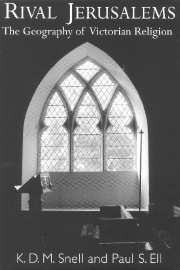Book contents
- Frontmatter
- Contents
- List of figures
- List of tables
- Preface and acknowledgements
- Introduction
- Part 1 Religious geographies: the districts of England and Wales
- Part 2 Religion and locality: parish-level explorations
- Technical appendices
- A Denominational statistics
- B The correction of census data
- C The religious measures
- D Computer cartographic methods
- E Landownership and the Imperial Gazetteer
- F An 1861 Census of Religious Worship?
- Bibliography
- Index
F - An 1861 Census of Religious Worship?
Published online by Cambridge University Press: 08 August 2009
- Frontmatter
- Contents
- List of figures
- List of tables
- Preface and acknowledgements
- Introduction
- Part 1 Religious geographies: the districts of England and Wales
- Part 2 Religion and locality: parish-level explorations
- Technical appendices
- A Denominational statistics
- B The correction of census data
- C The religious measures
- D Computer cartographic methods
- E Landownership and the Imperial Gazetteer
- F An 1861 Census of Religious Worship?
- Bibliography
- Index
Summary
The 1851 Religious Census was not repeated for a variety of reasons, which are worth outlining here. They shed light both on the political importance of the subject at the time, and the ways in which the 1851 Religious Census was viewed in retrospect by many contemporaries.
There was extensive debate in 1860 as to whether there should be another such census in 1861. Some (particularly Nonconformists) wanted an exact repeat of the 1851 census. Others wished to see a simple statement of ‘religious persuasion’, while others balked at the idea in any form. The importance of the 1851 census was obvious to all: ‘it was always used, and it has been over and over again quoted as exhibiting the numerical proportions of the different religious sects’. As Lord Robert Cecil (MP for Stamford) stated, the Religious Census ‘had been made the basis of reproaches against the Church of England, and attempts to undermine her position as an Establishment’. It ‘had been appealed to in continual debates with very telling effect’. This was despite his recollection that back in 1850 it had been intended ‘to frame the census upon a plan which it was thought might be favourable to the religious body which had the greatest political organization, and could apply the sharpest whip to its members’.
- Type
- Chapter
- Information
- Rival JerusalemsThe Geography of Victorian Religion, pp. 449 - 452Publisher: Cambridge University PressPrint publication year: 2000



